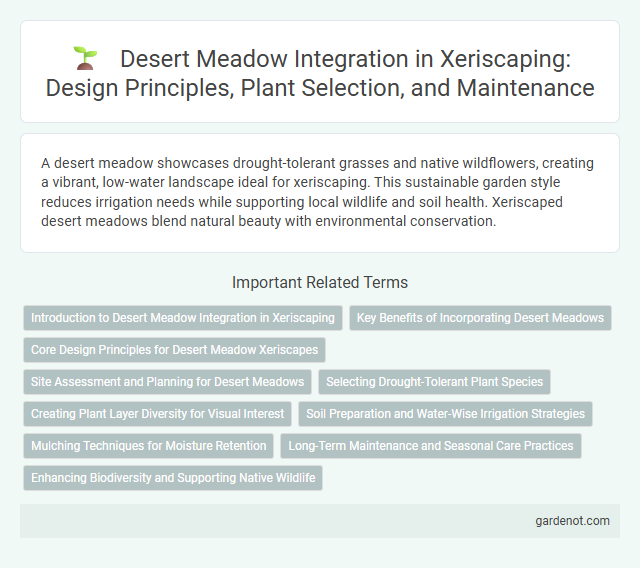A desert meadow showcases drought-tolerant grasses and native wildflowers, creating a vibrant, low-water landscape ideal for xeriscaping. This sustainable garden style reduces irrigation needs while supporting local wildlife and soil health. Xeriscaped desert meadows blend natural beauty with environmental conservation.
Introduction to Desert Meadow Integration in Xeriscaping
Desert meadow integration in xeriscaping emphasizes the use of drought-tolerant native grasses and wildflowers to create sustainable, low-water landscapes. By incorporating species such as blue grama, Indian ricegrass, and desert marigold, desert meadows enhance soil health, reduce erosion, and support local wildlife habitats. This approach aligns with xeriscaping principles by minimizing irrigation needs while maintaining aesthetic appeal and ecological balance.
Key Benefits of Incorporating Desert Meadows
Incorporating desert meadows in xeriscaping offers significant water conservation benefits, reducing irrigation needs by up to 50% compared to traditional lawns. These landscapes support native biodiversity by providing habitat for pollinators such as bees and butterflies, enhancing overall ecosystem health. Desert meadows also improve soil stabilization and reduce erosion, making them ideal for sustainable landscaping in arid regions.
Core Design Principles for Desert Meadow Xeriscapes
Desert meadow xeriscapes prioritize water-efficient native plants that thrive in arid climates, such as desert wildflowers, grama grasses, and succulents, ensuring minimal irrigation needs. Soil preparation emphasizes high permeability and organic content to retain moisture and support root systems, promoting sustainable growth with limited water resources. Design principles focus on plant grouping based on water requirements and sun exposure, creating visually appealing, low-maintenance landscapes that conserve water effectively.
Site Assessment and Planning for Desert Meadows
Site assessment for desert meadows involves evaluating soil composition, sunlight exposure, drainage patterns, and native plant species adaptability to ensure sustainable landscaping. Planning incorporates selecting drought-tolerant grasses and wildflowers that thrive in arid conditions, while optimizing irrigation efficiency through soil moisture analysis. Integrating contour grading and mulching techniques minimizes water runoff and enhances soil retention, essential for maintaining vibrant desert meadows.
Selecting Drought-Tolerant Plant Species
Choosing drought-tolerant plant species such as desert sage, purple coneflower, and blue grama grass enhances the resilience of a desert meadow xeriscape. These native plants require minimal irrigation, adapting naturally to arid environments while supporting local wildlife and conserving water resources. Proper selection and placement of drought-resistant flora optimize soil retention and reduce maintenance in sustainable landscaping projects.
Creating Plant Layer Diversity for Visual Interest
Desert meadows in xeriscaping enhance visual interest by incorporating diverse plant layers, including groundcovers, mid-height shrubs, and taller desert-adapted trees. Using native species such as desert marigold, globe mallow, and creosote bush promotes natural biodiversity and water efficiency. Layered planting not only creates texture and depth but also supports local wildlife and improves soil health in arid environments.
Soil Preparation and Water-Wise Irrigation Strategies
Desert meadow xeriscaping requires well-draining soil with enhanced organic matter to improve moisture retention and root penetration. Soil preparation techniques include deep tilling and incorporating compost or mulch to reduce evaporation and stabilize temperature. Water-wise irrigation strategies focus on drip irrigation systems and scheduled watering during cooler hours to maximize efficiency and minimize water waste.
Mulching Techniques for Moisture Retention
Mulching techniques in desert meadows play a critical role in moisture retention by reducing evaporation and enhancing soil health. Organic mulches such as shredded bark, compost, and straw create a protective layer that insulates soil, maintains consistent moisture levels, and suppresses weed growth. Effective mulching practices in xeriscape landscaping significantly improve water efficiency and promote sustainable desert meadow ecosystems.
Long-Term Maintenance and Seasonal Care Practices
Desert meadows require minimal long-term maintenance due to their drought-tolerant native grasses and wildflowers that adapt well to arid climates. Seasonal care practices include limited watering focused on early spring to promote growth and occasional mowing or controlled burns to prevent invasive species and maintain plant health. Soil aeration and monitoring for pest infestations during the dry season are essential to preserving the ecosystem's balance and vitality.
Enhancing Biodiversity and Supporting Native Wildlife
Desert meadows in xeriscape gardens create vital habitats that boost biodiversity by supporting a variety of native plants and pollinators adapted to arid conditions. These ecosystems provide essential food and shelter for local wildlife such as bees, butterflies, and birds, promoting ecological balance. Utilizing drought-tolerant native grasses and wildflowers ensures sustainable growth while conserving water resources in xeriscape landscapes.
Desert meadow Infographic

 gardenot.com
gardenot.com